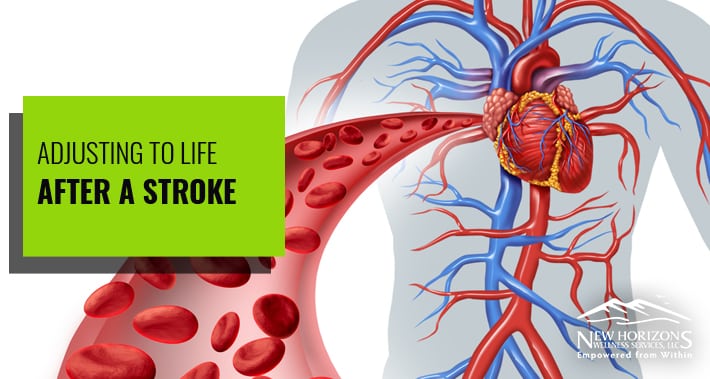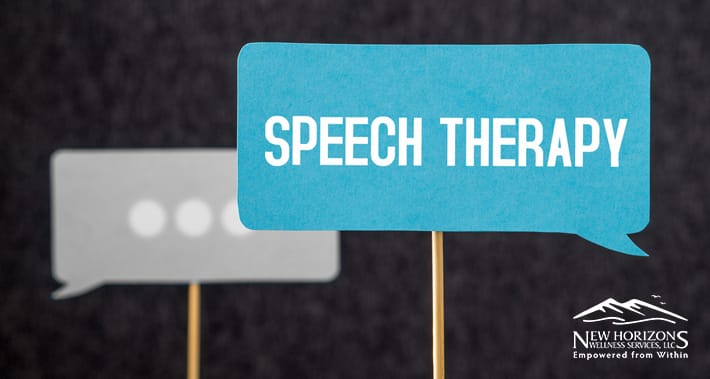
Strokes are one of the leading causes of death and adult disability in the United States.
In fact, according to the CDC, more than 795,000 Americans suffer from a stroke every year.
Following a stroke, many people will experience difficulties such as:
- Cognitive issues
- Struggles to control emotions
- Paralysis
- Muscle weakness
- Communication problems
These symptoms can make returning to everyday life difficult.
However, there are mental & physical health treatments, like those offered here at New Horizons Wellness Services, that can help make your recovery more manageable.
It’s important to educate yourself on the conditions and treatments surrounding strokes, as early detection can be the difference between life and death.
Read on to learn more.
What Is A Stroke?
A stroke occurs when your blood’s usual path to the brain is reduced or disrupted.
When the flow of blood into your brain is obscured, it can prevent your brain tissue from getting enough oxygen and nutrients to function properly, resulting in the death of brain cells.
This reduction can be due to a blot clot (ischemic stroke), or a broken blood vessel (hemorrhagic stroke).
If caught in time, there are effective treatments to reduce the possibility of death and disability from your stroke.
However the timing of treatment is crucial, as brain cells can begin to die within minutes of the reduction of blood flow.
The medical term for a stroke is a cerebrovascular accident – so if you hear your doctor talking about a “CVA”, they’re referring to a stroke.
What Causes A Stroke?
Strokes have two primary causes: the blockage of blood flow and the unwanted leakage or bursting of a blood vessel.
When a stroke is caused by the blockage of an artery, it’s classified as an Ischemic stroke.
If a stroke is caused by the leakage or the rupture of a blood vessel it’s classified as a hemorrhagic stroke.
Preexisting conditions such as diabetes, high blood pressure, heart disease, and damages from smoking tobacco are amongst the most known causes of a stroke.
1. Ischemic Stroke
Ischemic strokes are the most common type of stroke.
They occur when the blood vessels in the brain become narrowed or entirely blocked off.
These blockages are created from either fatty deposits that have built up over time in blood vessels, a blood clot, or other debris traveling through your bloodstream.
These changes to the blood vessels greatly reduce the number of nutrients reaching your brain tissue, resulting in brain cell death.
2. Hemorrhagic Stroke
While ischemic strokes are the result of blocking the blood’s passageways, hemorrhagic strokes occur when a blood vessel in your brain ruptures or leaks.
Brain hemorrhaging can be the result of different conditions affecting your blood cells.
Important conditions to note as possible causes of hemorrhaging include:
- Trauma – potentially from past impacts and injuries
- Ischemic stroke – can lead to hemorrhaging
- Cerebral amyloid angiopathy – weakness in the vessel wall caused by protein deposits
- Unregulated high blood pressure
- Overtreatment with blood thinners – anticoagulants
- Aneurysms – nodules at weak spots in your blood vessel walls
- Arteriovenous malformation – the rupture of thin walled blood vessels in an abnormal tangle
3. Transient Ischemic Attack
Sometimes referred to as a mini stroke, a transient ischemic attack (TIA) is a temporary experience of stroke like symptoms.
Similar to ischemic strokes, a TIA is the result of a partial blockage of blood flow to the brain.
TIA can last up to 24 hours, but it’s rare and most are only a few minutes long.
In the majority of cases, a TIA is short lived and won’t cause permanent damage.
If your TIA comes and goes before you can receive medical attention, you should still check in with a doctor immediately.
Not only is it difficult to distinguish a TIA from a regular stroke, but you may be at a higher risk for a full stroke in the future.
A TIA signifies that you have a narrowing or blockage in an artery to your brain.
If left unaddressed, this narrowing may lead to a full blockage and a major stroke in the future.
What Are The Symptoms Of A Stroke?
It’s important to familiarize yourself with the early symptoms of a stroke.
Paying attention to these early symptoms may save you from developing long lasting stroke symptoms and even death.
Indicators and symptoms of a stroke may include:
Numbness
Numbness or paralysis of the arm, leg, or face – this often affects one side of your body.
If you notice a weakness in these areas, try raising both of your arms simultaneously over your head.
If one arm begins to drop, you may be having a stroke.
You may also see that one side of your mouth droops when you smile.
Headache
A sudden, intense headache may indicate that you’re having a stroke.
These headaches can also be accompanied by altered consciousness, dizziness, and vomiting.
Issues with speaking and comprehending what others are saying – slurred speech, confusion, and difficulty understanding others’ speech.
Vision Problems
Difficulties with one or both eyes can indicate a stroke.
This can include seeing double, blurred vision, and blackened vision.
Coordination issues
Stumbling, losing balance, dizziness, and trouble with walking are all signs of a stroke.
If you notice any one of these symptoms, call 911 immediately.
When it comes to a stroke, immediate treatment is essential to your safety.

How Can A Speech Therapist Help You Recover From A Stroke?
When a stroke takes place in the area of your brain that produces communication and speech it can cause aphasia .
Aphasia is a grouped term for speech and language impairments that affect reading, writing, speech, and communication skills.
Approximately 25-40% of stroke survivors have some form of aphasia.
Adult speech therapy interventions can help stroke survivors who struggle to regain typical speech patterns.
Based on what your needs are, your Tigard Oregon speech therapist may work with you through a variety of different interventions.
In general, these interventions are designed to help you:
- Improve your clarity of speech
- Understand spoken or written words
- Follow directions
- Recall words
- Write words and sentences
- Problem solve
- Improve your memory
- Participate in conversations
- Swallow
There are a wide range of different interventions your speech therapist might use to accomplish this, including but not limited to:
Breathing training – aphasia can present itself as trouble regulating breath with speaking, breathing exercises will help you build up your stamina, and plan your breathing in conversations.
Tongue strengthening training – weakness from a stroke can affect the tongue and make forming words difficult
Practicing speech sounds – repetition of sets of sounds such as “Ah, ay, at, al, ack” to improve muscle strength and memory.
Naming pictures – while some stroke survivors struggle to physically speak, others struggle to say the word they are thinking of.
This activity aims to strengthen the connection between words and images.
Sentence practice – other stroke survivors may find individual words easy to say, but struggle to string together proper sentences.
How Can An Occupational Therapist Help You Recover From A Stroke?
In the context of stroke survivors, occupational therapy can be a huge asset to creating a more fulfilling life.
After a stroke, you may experience a myriad of challenges, such as a decline in cognitive and emotional functioning, a decrease in community participation, physical weakness on one side of the body, social disability, and an inability to walk and care for yourself.
You can work with an occupational therapist for stroke recovery to address these challenges and to create an activity plan that works for you.
Your brain is multifaceted and your plan to tackle these new obstacles should be too.
Occupational therapists help you to address your challenges at all stages in the continuum of care.
Occupational therapy practitioners work in collaboration with your caregivers, your family and you, to determine which activities are meaningful, relevant, and necessary to you.
Through their clinical expertise and the philosophical basis of their profession, an occupational therapist can analyze your interactions, necessary environments to function, and which occupations you want or need to perform.
Some patients may find that after their stroke, their emotional, physical, and cognitive abilities dampen their abilities to work, parent, study, and even relax.
In analyzing the effects of the stroke, as well as your individual wants and needs, an occupational therapist’s services may include:
Daily Activities
Addressing ongoing difficulties that limit your daily activities such as cooking, parenting, and managing money.
These activities can be trying while dealing with cognitive or visual impairments, physical weakness, and sensory loss.
It also includes dealing with issues related to swallowing, driving, sexual intimacy, and other daily activities.
Retraining
Continued retraining in adapting skills, self-care skills, and adapting environments.
This can include the proper use of adaptive equipment to optimize daily living.
Adjusting Your Worksite
Performing worksite evaluation and doing a work related task analysis.
From there they may recommend ways to modify your workplace and educational facilities.
Community Reintegration
Returning to your community after a stroke will often need modifications to maximize your independent engagement.
Mental Health Support
Developing coping strategies to support psychosocial health and well-being
These may include calming exercises, relaxation techniques, and mental health counseling
In some cases, your OT will work with you through the rehabilitation process to prepare you for life after discharge.
As a part of this process, your OT will also work alongside your caregiver, preparing them for the challenges ahead.
Depending on your physical abilities, your OT may suggest home modifications and train you in assistive technology.
When offering assistive technology solutions such as AAC, your OT will often work with vendors to ensure they are recommending the most appropriate option based on your needs.
From there they will set the technology up, and provide you with training on how to use it.
Book An Appointment With New Horizons Wellness Services
If you or a loved one are struggling to find your new normal after a stroke, feel free to contact us about potential mental & physical health treatments to help your journey.
Book your appointment with New Horizons Wellness Services today.
Yours in Health,
New Horizons Wellness Services13333 SW 68th Pkwy,
Tigard, OR 97223
- https://g.page/newhws
New Horizons Wellness Services provides a true multidisciplinary approach to mental & physical health treatments for children, adults and families.
